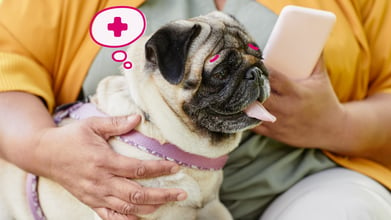Stress-Free Tips for Giving Pets Medication at Home

Giving your pet medication can cause anxiety for you and your furry friend. However, with the right approach, the process can be smoother and less daunting.
This guide will provide valuable tips and techniques to help you safely and effectively administer medication to your pet at home.
🔑 Key Takeaways:
-
A relaxed environment can significantly reduce stress for both you and your pet during medication administration.
-
Different pets respond to different medication methods. Experiment with different techniques to find what works best.
-
Consistent practice can help desensitize your pet to taking medication, making the process smoother over time.
General Tips for Giving Pets Medication
Administering medication to your pet doesn't have to be stressful. By following these general tips, you can create a calmer experience for both you and your pet.
Stay calm
Pets can sense your anxiety, so it's important to remain calm and reassuring throughout the process.
Choose a quiet environment
Minimize distractions to help your pet relax and focus.
Use as directed
Adhere to the dosage medications prescribed in order for them to work effectively.
Don’t skip a dose
Finish the entire medication as directed, even if your pet appears better.
Use high-value treats
Hiding medications in high-value food or treats can mask the medication, allowing you to medicate your pet without them noticing. Use in moderation to prevent an upset stomach.
Examples of high-value food or treats:
-
Peanut butter
-
Wet food
-
Cheese (use caution)
-
Deli meat
-
Other favorite foods
-
Purée treat pouches such as Churu
-
Pill pockets
Compounded medications
Some medications can be compounded into a flavored liquid or treat, allowing for easier administration.
Common flavors include:
-
Chicken
-
Fish
-
Beef
-
Marshmallow
-
Peanut butter
Crush & mix
Some (not all) medications can be crushed or mixed into water, broth, or other favorite liquid, then placed in wet food for consumption or administered by a syringe.
Offer a reward
Make the pill-giving experience fun and exciting by offering treats before and after giving the medication.
Practice makes perfect
Gradually introduce the medication process through play to desensitize your pet.
Enlist help
Some pets may benefit from having an extra set of hands to help hold and keep your pet calm while you administer the medication.
Desensitize to handling
Regularly handling your pet’s mouth, paws, and ears during non-medication times can help them become accustomed to being touched in these areas, making the process less stressful when medications are needed.
Pill Dispensers
Pill dispensers or pill poppers can help place the pill directly at the back of your pet’s throat, reducing the chance they will spit it out.
Administering Liquid Medication to Pets
Liquid medications can be a challenge, especially for our feline friends. Let’s explore some effective techniques for giving your pet their liquid medicine.
Cats
Some cats may consume liquid medication mixed in with their favorite wet food or liquid purée. For cats that are more resistant to handling, when it is time to give liquid medication, it may be best to wrap them in a heavy towel like a burrito with their head exposed out the front to prevent scratches.
Keep their heads facing away from the dropper or syringe and come from behind. Slowly administer the liquid through the side of your cat’s mouth. Don’t let them loose until you know they’ve swallowed the dose.
Dogs
To administer liquid medication to dogs, simply mix the medication thoroughly with some food or treats they love and place the concoction in their food bowl.
For some dogs that are more sensitive to tastes and smells, you can sit with them on the ground, with them positioned between your knees and facing forward. Gently administer the medication through the side of their mouth.
Tips to Give Pills to Your Pets
Ideally, your pets will accept a pill placed with their favorite food or yummy treat. It’s important to make sure they swallow the full dose and do not spit out the pill.
Many pet parents have luck directly placing the tablet or capsule in the back of the throat and encouraging their pet to swallow right after. With time and practice, you can quickly and effectively master the art of pill administering. Ask your veterinary team for a demonstration and more tips.
How to Give Your Pets Injectable Medication
Medications such as insulin or subcutaneous fluids can be given as an injection under the skin (subcutaneously) at home with veterinary approval. When working with injectable medications, it is important to follow handling and storage instructions closely.
Follow your veterinarian's instructions closely and ask for a full demonstration before administering injectable medications at home.
Some tips for administering injectable medication to your pet include:
-
Offer treats or high-value food as a helpful distraction.
-
Giving injections at meal times can also be beneficial.
-
Enlist help or use a towel or blanket to restrain your pet when injectable medications are given to ensure they do not move.
-
With time and training, many pets will hold still for owners without additional help.
If you don’t feel comfortable or feel that it is unsafe to inject your pet at home, schedule an in-home medication appointment with a BetterVet veterinarian or veterinary technician for your peace of mind.
Conclusion
Successfully administering medication to your pet requires patience, practice, and a calm demeanor. By following the tips and techniques outlined in this guide, you can make the process smoother for both you and your furry friend. Remember, every pet is different, so it may take some trial and error to find the best approach.
If you continue to struggle, don’t hesitate to consult your veterinarian for personalized guidance.
Virtual Vet Visits for Your Peace of Mind
Connect with an online vet from the comfort of your home. Convenient, affordable, and stress-free!
Frequently Asked Questions
How do you give pills to a dog that refuses?
Try hiding the medication in a high-value treat or placing the pill as far back in your pet's mouth as possible, then gently closing their mouth and holding it shut for a few seconds. You can also try using a pill popper or asking your vet for a demonstration.
How do I give my cat liquid medicine by myself?
Wrapping your cat in a towel (like a burrito) can help restrain them. Administer the medication quickly and reward them afterward with treats.
How to open a dog's mouth to give medicine?
If your dog refuses to open their mouth wide enough to get the medicine down, you can try a pill popper, which is small enough to fit through even a small opening in your dog’s mouth.
Can I crush all medications and mix them with food?
Not all medications can be crushed. Some medications require specific administration methods. Always check with your vet before crushing and mixing any medication.






